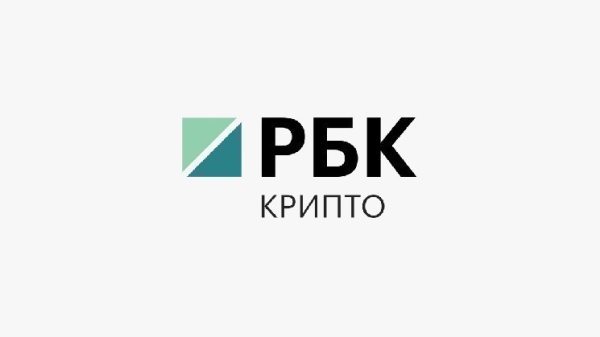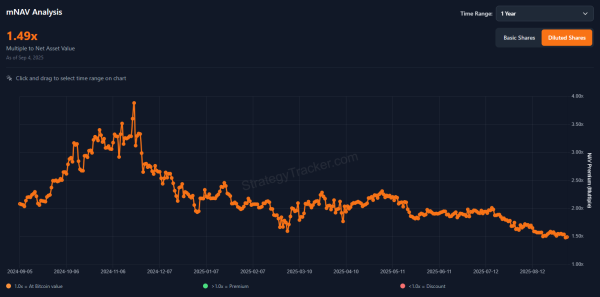Strategy's Bitcoin Premium at Two-Year Low: Why It's Dangerous
 Strategy's Bitcoin Investment Strategy Fails in 2025, Shares Lose Tens of Percentages
Strategy's Bitcoin Investment Strategy Fails in 2025, Shares Lose Tens of Percentages
Shares of Strategy (ticker MSTR), the largest public holder of bitcoin run by Michael Saylor, have fallen by almost a third since their July 2025 peak. Over the same period, the price of bitcoin has fallen by about 10%. That has led to a drop in the premium MSTR has over the company's bitcoin holdings, a key metric for investors.
Strategy's performance as the first company to bet on accumulating cryptocurrency as a corporate reserve has in many ways set the benchmark for hundreds of other organizations that have chosen a similar investment model, Fortune writes.
The premium refers to the mNAV, which measures a company’s market cap relative to its holdings of bitcoin or other assets. MSTR shares have risen nearly 700% in 2024, significantly outperforming bitcoin, which has risen nearly 150% from its start to its peak in 2024. This dynamic has allowed Strategy to increase its mNAV from 1.2 at the start to 3.9 at the end of last year. Put simply, the stock has risen much faster than the underlying asset (bitcoin).
rbc.group
The essence of the strategy
This stock performance relative to Bitcoin has allowed the company to raise billions of dollars in borrowed capital to finance additional Bitcoin purchases. According to Bitcointreasuries, Strategy has been able to increase its Bitcoin reserves by 257,000 Bitcoins (by $28.2 billion at the exchange rate at the beginning of September) in 2024, bringing them to almost 450,000 ($49.5 billion). As of September 4, Strategy has accumulated more than $70 billion, or 636,505 BTC.
Investors' interest in investing in Strategy is due to the fact that the company issued debt obligations with the ability to convert them into MSTR shares in the future if they reach a certain price range. As a rule, this is several tens of percent of potential profit for investors, and for Strategy – the opportunity to provide purchases of new bitcoins with virtually no risk.
Strategy has become an example for dozens of other companies that have decided to add cryptocurrencies as a reserve. As of early September, the Bitcointreasuries service showed more than 180 organizations that have accumulated a total of more than 1 million BTC, or more than $110 billion at the current rate. In addition to Bitcoin, companies are also accumulating other cryptocurrencies. For example, StrategicETHreserve showed that more than 70 organizations have accumulated more than $20 billion in Ethereum.
While Strategy's scheme was proving successful and other companies were adopting its experience, few people thought about the risks, but in the second half of the year the situation changed.
The company switched to a new type of capital raising. Instead of debt securities, it began to use the placement of preferred shares – STRF, STRK ATM, STRD. This mechanism allows raising capital without diluting the shares of existing shareholders.
Fall in premium
While the price of Bitcoin has risen by about 20% since late 2024, when MSTR's premium to BTC was 3.9x, MSTR stock has lost 40% since then.
Since late 2024, the premium has been gradually declining, from a peak of around 3.9 to 1.49 on September 4. Ultimately, the situation led to a change in Strategy. When the MSTR price reached its 2025 peak of almost $460, the company committed to not issuing shares with an nMAV below 2.5. That was in late July.
But just a few weeks later, on August 25, the company sold almost 900,000 new shares. This happened just as Bitcoin reached its all-time high of $124,500 on August 24. Strategy immediately used the funds raised to buy another batch of Bitcoin, according to its report for September 2.
 MSTR to Bitcoin Premium (nMAV) Chart from Late 2024 to September 4, 2025. Source: Saylortracker
MSTR to Bitcoin Premium (nMAV) Chart from Late 2024 to September 4, 2025. Source: Saylortracker
And while the premium could be expected to fall when the price of Bitcoin declines, this year the price of Bitcoin has remained virtually unchanged, and the MSTR mNAV premium is still declining. Experts wonder what will happen to the indicator if Bitcoin falls significantly.
“What happens when Bitcoin drops 50%? Enthusiasm for digital asset management companies will wane, mNAV will shrink,” says Capriole founder Charles Edwards.
In addition, questions arise about Strategy not fulfilling its promises regarding the absence of additional shares issuance, so as not to dilute investors' stakes while mNAV is below 2.5.
“The move away from the guidance of no equity issuance below 2.5x mNAV has forced a rethink of the company’s near-term strategy,” said Jake Ostrowskis, chief market analyst at Wintermute’s OTC division.
“We learned that starting a company that manages bitcoin is not uncommon. Anyone can set up a company, try to go public, and raise money to buy bitcoin,” said Jack Mallers, CEO of Twenty One Capital, a company that accumulates bitcoin.
MSTR has already experienced a multi-year period of low premium, with nMAV below 2.0 from early 2021 to early 2024. But during this period, the company also managed to accumulate Bitcoin through debt capital.
Source: cryptonews.net



